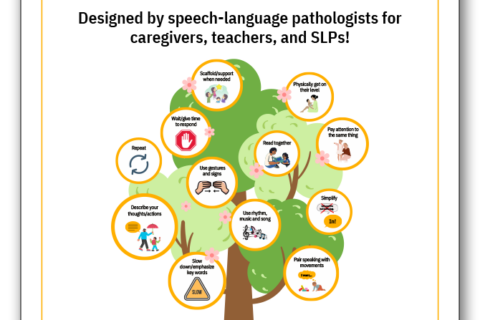Online Speech Therapy Options for Preschool Children

For years, the effectiveness of online speech therapy for adults has been well touted. In current times, an increasing number of people are realizing the positive impact it can have on children, especially toddlers and preschool children, who need to improve their speech, language, and literacy skills.
As another school year ensues and another educational benchmark begins, our goal is to provide you with a comprehensive guide to online speech therapy options for your child. We spoke with Open Lines® founder and executive director, Dr. Jessica Galgano, to learn more about the benefits of speech therapy from the comfort of your home, how parents can stay involved, and techniques and exercises you can become familiar with.
The Importance of Early Intervention
The early years of your child’s language development are critical. Why? The brain is the most receptive to learning at this stage, and in the early years, it learns foundational skills your child needs to grow and develop.
Like many things in health care, the sooner a child receives care, the better the outcomes can be. Therefore, early intervention is key, but intervention at any time is still helpful.
Principles of neuroplasticity demonstrate younger brains can quickly adapt to change and intervening early can set your child up for success in social and academic settings before delays can compound and lead to other issues. You will be able to see your child’s increased confidence and ability to communicate, which leads to many benefits, such as reduced frustration and tantrums in everyday activities.
Online Speech Therapy Benefits
Online speech therapy is beneficial for children with a wide range of strengths and needs.
“When seeing a speech-language pathologist (SLP) who specializes in online therapy and evidence-based research, children demonstrate notable progress, meeting and exceeding established goals in many areas, including articulation, expressive and receptive language, pragmatic/social language, stuttering/dysfluency, and healthy voice production,” Dr. Galgano said.
She noted there are also unexpected perks to online sessions. Conducting speech therapy in your child’s home environment allows skills to generalize more quickly to day-to-day and academic life.
“Online sessions use a variety of strategies and innovative games and activities to ensure the online modality is engaging and effective with enabling children to confidently communicate with friends, teachers, and families for both social and academic success,” Dr. Galgano said.
Your child may also feel more comfortable in their home environment, removing any stigma associated with going into an office setting. There is also a component of time-saving benefits because you will no longer need to set aside a part of your day for commuting to and from a private office.
Online speech therapy exercises and games for kids
The beauty of online speech therapy is there are many methods, techniques, innovative games, and activities used in the office setting that translate well to online use.
Your SLP can tailor the exercises and techniques used online to your child’s specific strengths and goals. After an evaluation, they may opt for a more clinician-centered approach or a child-centered approach. Age, ability to complete tasks and motivation in speech therapy will help determine which approach is best. Read more details on what happens during your child’s speech therapy session.
“You can interview your clinician to determine which style they believe would benefit your child most,” Dr. Galgano said. “Some children benefit more from a structured approach where they complete specific tasks to strengthen their individual speech and language tasks while sitting at the table with minimal distractions (clinician-centered), whereas others may benefit more from open-play where the clinician capitalizes on the specific toys/games that interest your child and target development of speech and language skills within a play format or structure (child-centered).”
Each domain of speech and language will involve different exercises to target articulation, fluency, voice, and/or language.
Articulation
Your clinician may teach your child how to correctly produce a sound and then move through a hierarchy where they practice this sound in words, sentences, stories, and conversation until your child can produce this sound with ease in everyday life.
Fluency
Your clinician may teach your child to identify bumpy speech and smooth speech and then model strategies that will lead to improvements.
Voice
Your clinician may teach your child a series of motor-speech exercises where they learn to produce a healthy voice using a basic sound and then transition this voice into the conversation.
Language
Your clinician may first build your child’s understanding of words using games and books and then help your child increase the complexity of their sentences by participating in sentence-building activities and modeling more detailed sentences.
Parents’ Role in Online Speech Therapy
As a parent, you can and should be an active participant in online speech therapy with your child.
For starters, you can set up a comfortable and practical space, including an appropriately sized chair and a desk where your child can sit with their face within the camera’s view. You can also ensure materials and toys are accessible before the session begins. Your clinician can provide instruction on which materials would be helpful to have on hand.
“Your child should be in a space where there are minimal distractions,” Dr. Galgano said. “To help your child feel included in the process, you can invite them to decorate their space by hanging artwork on the wall or decorating their furniture. Additionally, if your child has siblings, you can also provide them with an activity, in a separate room if possible, that will keep them entertained. Depending on the child’s age and needs, a parent may be a co-facilitator in the therapy sessions.”
In conclusion, you can also help your child make faster progress by practicing the home exercise plan provided by your SLP between speech therapy sessions. There are several strategies your entire family can use at home to communicate with your child. They may include giving your child increased wait time, slowing down your rate of speech, speaking to your child at their language level, using books and pictures to improve your child’s vocabulary, or expanding upon their utterances using receptive language and language modeling.
“As a parent, when you are provided with education and training, it is a wonderful way to affirm what you are already doing correctly and find out more information and strategies to help your child grow and develop,” said Dr. Galgano, who recommends finding an SLP who uses a comprehensive and collaborative approach to help address your family and your child’s needs.
Keeping Your Preschooler Engaged
Engagement can be the biggest hurdle with online sessions compared to in-person appointments. Having your toddler stay engaged is a key factor in their outcome. Talk to your SLP about ways in which they can meet your child’s goals.
Your child may enjoy their sessions and find the games exciting, but when a task is frustrating, they may step away from the computer. These interactions can be tricky when the clinician is not present to redirect your child back to their seat. Having a parent or caregiver present to redirect your child as needed is an ideal way to remedy this.
Your speech therapist can tailor books, pretend play, iPad apps, and even board games for online use that appeal to your child’s specific interests and preferences. For example, if your child has a favorite TV or storybook character, your clinician can incorporate this character into speech games as well as reward systems.
Generally, many children enjoy participating in short modules of exercise where they practice a specific skill for five to 10 minutes and then receive a break for one to three minutes between exercises. You can also establish reward systems and include things, such as receiving a sticker on a visual schedule when they complete a task, to help them earn playtime at the end of the session. During this playtime, your clinician will provide you with an update on your child’s progress.
You can then keep your child further engaged through every activity they participate in, including bath time. Each night before bed, you can encourage creative play, language, and literacy by using different vocabulary and expanded sentence lengths while your child is in the tub. You can even use alphabet letters that float in water to encourage print awareness and pre-literacy skills or improve the clarity of speech.
How to Get Started
If you have concerns about your child’s speech, language, or literacy development, contact a certified speech-language pathologist. They will answer your initial questions (read our frequently asked questions for more specific topics) and walk you through the assessment and treatment process. We also created a pediatric speech therapy evaluation and treatment flow chart to help you gain a better understanding of when to seek help for your child and how to plan your next steps.
The SLP may recommend a comprehensive speech and language evaluation to provide a clearer picture of your child’s speech and language strengths and relative weaknesses. They will also evaluate aspects of your child’s cognition, executive function, and recall skills if they are impacting language.
An evaluation may examine the following skills and how they impact personal or academic functioning:
- Articulation: Pronunciation of words and speech clarity or intelligibility
- Expressive language: Vocabulary, sentence structure, storytelling, and conversation skills
- Receptive language: Following directions and processing language that is heard
- Literacy: Decoding to read and understand written text, as well as writing
- Speech motor fluency
- Voice Production
“Your child’s clinician should outline a treatment plan and home exercise program to address any delays that may be present or provide a plan to strengthen weak skills that need a boost when no delay is present,” Dr. Galgano said. “Your child and family will then be able to move forward and begin speech therapy or tutoring from the comfort of your own home to ensure social and academic success.”
There is no one-size-fits-all approach to speech therapy online. The time spent will vary, although many children will take part in a program for at least three months. Your SLP can give you a time frame based on your child’s unique strengths and needs, and they should provide you with progress updates. Progress will depend on the frequency of treatment, consistent attendance, and committed practice at home to supplement sessions.
If you’re struggling with communication difficulties, it’s time to turn to Open Lines®. Contact us via phone (212-430-6800), email [email protected], or by filling out our convenient contact form. Improve your communication skills and unlock your potential with Open Lines® Speech and Communication in New York today!
Get in Touch With Open Lines®














